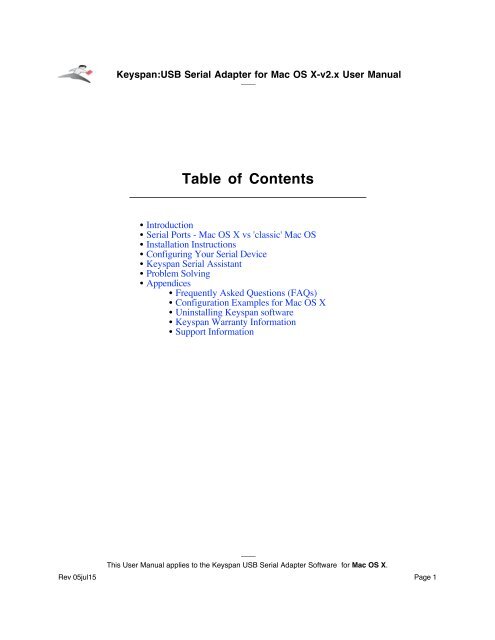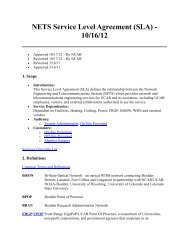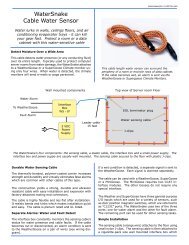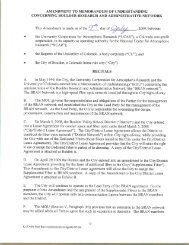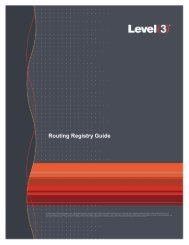Keyspan:USB Serial Adapter for Mac OS X - NETS
Keyspan:USB Serial Adapter for Mac OS X - NETS
Keyspan:USB Serial Adapter for Mac OS X - NETS
- No tags were found...
You also want an ePaper? Increase the reach of your titles
YUMPU automatically turns print PDFs into web optimized ePapers that Google loves.
<strong>Keyspan</strong>:<strong>USB</strong> <strong>Serial</strong> <strong>Adapter</strong> <strong>for</strong> <strong>Mac</strong> <strong>OS</strong> X-v2.x User ManualTable of Contents• Introduction• <strong>Serial</strong> Ports - <strong>Mac</strong> <strong>OS</strong> X vs 'classic' <strong>Mac</strong> <strong>OS</strong>• Installation Instructions• Configuring Your <strong>Serial</strong> Device• <strong>Keyspan</strong> <strong>Serial</strong> Assistant• Problem Solving• Appendices• Frequently Asked Questions (FAQs)• Configuration Examples <strong>for</strong> <strong>Mac</strong> <strong>OS</strong> X• Uninstalling <strong>Keyspan</strong> software• <strong>Keyspan</strong> Warranty In<strong>for</strong>mation• Support In<strong>for</strong>mationThis User Manual applies to the <strong>Keyspan</strong> <strong>USB</strong> <strong>Serial</strong> <strong>Adapter</strong> Software <strong>for</strong> <strong>Mac</strong> <strong>OS</strong> X.Rev 05jul15 Page 1
<strong>Keyspan</strong>:<strong>USB</strong> <strong>Serial</strong> <strong>Adapter</strong> <strong>for</strong> <strong>Mac</strong> <strong>OS</strong> X-v2.x User Manual1.1 - IntroductionThe <strong>Keyspan</strong> <strong>USB</strong> <strong>Serial</strong> <strong>Adapter</strong> Software <strong>for</strong> <strong>Mac</strong> <strong>OS</strong> X allows you to add serial ports to your<strong>Mac</strong> <strong>OS</strong> X computer. Using <strong>Mac</strong> <strong>OS</strong> X native software, you can use your <strong>Keyspan</strong> <strong>USB</strong> to <strong>Serial</strong><strong>Adapter</strong> to communicate with various serial devices via the P<strong>OS</strong>IX API (<strong>for</strong> more in<strong>for</strong>mation,<strong>Serial</strong> Ports - <strong>Mac</strong> <strong>OS</strong> X vs 'Classic' <strong>Mac</strong> <strong>OS</strong> section in this manual) .Important Note:The <strong>Keyspan</strong> <strong>USB</strong> <strong>Serial</strong> <strong>Adapter</strong> Software <strong>for</strong> <strong>Mac</strong> <strong>OS</strong> X will add '<strong>Mac</strong> <strong>OS</strong> X serial ports' to yourcomputer. These '<strong>Mac</strong> <strong>OS</strong> X serial ports' can only be used by <strong>Mac</strong> <strong>OS</strong> X native software (ie aprogram that does not require the Classic environment to run). If you are not certain if yourserial device's software can access <strong>Mac</strong> <strong>OS</strong> X serial ports, please read the <strong>Serial</strong> Ports - <strong>Mac</strong><strong>OS</strong> X vs 'Classic' <strong>Mac</strong> <strong>OS</strong> section in this manual. Examples of serial devices that use <strong>Mac</strong> <strong>OS</strong>X serial ports are modems using PPP (<strong>for</strong> internet access - configured via the NetworkingSystem Preference icon), Palm Handhelds (using Palm's HotSync Manager), and UPS devices(using PowerGuardian software - www.benatong.com).RequirementsThe <strong>Keyspan</strong> <strong>USB</strong> <strong>Serial</strong> <strong>Adapter</strong> Software <strong>for</strong> <strong>Mac</strong> <strong>OS</strong> X requires the following:• <strong>Mac</strong>intosh:• At least one available <strong>USB</strong> port• <strong>Mac</strong> <strong>OS</strong> X (10.1.3 or greater)• For use with one of the following <strong>Keyspan</strong> <strong>USB</strong> to <strong>Serial</strong> <strong>Adapter</strong>s:<strong>USB</strong> Twin <strong>Serial</strong> <strong>Adapter</strong> (pn# USA-28X)<strong>USB</strong> PDA <strong>Adapter</strong> (pn# USA-19, USA-19X, USA-19Qi, USA-19Q)High Speed <strong>USB</strong> <strong>Serial</strong> <strong>Adapter</strong> (pn# USA-19W, USA-19QW)<strong>USB</strong> 4-Port <strong>Serial</strong> <strong>Adapter</strong> (pn# USA-49W, USA49WLC, 4E230)<strong>USB</strong> <strong>Serial</strong> Port <strong>Adapter</strong> (pn# USA-18X)<strong>USB</strong> <strong>Serial</strong> <strong>Adapter</strong> (pn# USA-28)Mini Port Replicator (pn# UPR-112/UPSH-112 - only supports serial)<strong>USB</strong> <strong>Serial</strong> <strong>Adapter</strong> (pn# USA-19H)Note: This documentation applies to <strong>Keyspan</strong>'s <strong>USB</strong> <strong>Serial</strong> <strong>Adapter</strong>Software <strong>for</strong> <strong>Mac</strong> <strong>OS</strong> X and covers the features and use of this softwareon that plat<strong>for</strong>m. For specific in<strong>for</strong>mation about <strong>Keyspan</strong>'s <strong>USB</strong> to<strong>Serial</strong> <strong>Adapter</strong> hardware, please visit <strong>Keyspan</strong>'s web page or read the <strong>Keyspan</strong> <strong>Mac</strong> <strong>OS</strong> 9 User Manual<strong>for</strong> that product.This User Manual applies to the <strong>Keyspan</strong> <strong>USB</strong> <strong>Serial</strong> <strong>Adapter</strong> Software <strong>for</strong> <strong>Mac</strong> <strong>OS</strong> X.Rev 05jul15 Page 2
<strong>Keyspan</strong>:<strong>USB</strong> <strong>Serial</strong> <strong>Adapter</strong> <strong>for</strong> <strong>Mac</strong> <strong>OS</strong> X-v2.x User Manual2.1 - <strong>Serial</strong> Ports - <strong>Mac</strong> <strong>OS</strong> X vs 'classic' <strong>Mac</strong> <strong>OS</strong>This section is intended to briefly explain how 'older' <strong>Mac</strong> <strong>OS</strong> (<strong>Mac</strong> <strong>OS</strong>es released be<strong>for</strong>e <strong>Mac</strong> <strong>OS</strong>X. ie <strong>Mac</strong> <strong>OS</strong> 8.1 through 9.x) serial ports differ from serial ports on <strong>Mac</strong> <strong>OS</strong> X. This section isintended as an overview to help you decide whether or not you need to install <strong>Keyspan</strong>'s <strong>USB</strong><strong>Serial</strong> <strong>Adapter</strong> software <strong>for</strong> <strong>Mac</strong> <strong>OS</strong> X.Please note that when 'older <strong>Mac</strong> <strong>OS</strong>es' is used in lowercase, we are referring to an operating system or applicationsoftware that was made prior to <strong>Mac</strong> <strong>OS</strong> X.When 'CLASSIC' is used in UPPERCASE, we are referring to Apple's CLASSICenvironment that allows certain older (or 'classic') software to run under <strong>Mac</strong> <strong>OS</strong> X.Which <strong>Keyspan</strong> Software Should I Use?There are basically 2 requirements in order <strong>for</strong> your serial device to work natively on <strong>Mac</strong> <strong>OS</strong> X:1. a <strong>Mac</strong> <strong>OS</strong> X serial port(provided by <strong>Keyspan</strong>'s software and hardware )2. a serial device that has <strong>Mac</strong> <strong>OS</strong> X software(that can see/access <strong>Mac</strong> <strong>OS</strong> X serial ports e.g. modem)Note: We will be posting a list of <strong>Mac</strong> <strong>OS</strong> X compatible serial devices soon. The URL<strong>for</strong> this page is .Since some serial devices are not <strong>Mac</strong> <strong>OS</strong> X compatible, you may find cases where it is better tonot install the <strong>USB</strong> <strong>Serial</strong> <strong>Adapter</strong> software <strong>for</strong> <strong>Mac</strong> <strong>OS</strong> X and install the <strong>USB</strong> <strong>Serial</strong> <strong>Adapter</strong>software <strong>for</strong> <strong>Mac</strong> <strong>OS</strong> 8.6-9.x instead.For this reason, we ask you read this guide to help you in determining whether or not you need toinstall the <strong>USB</strong> <strong>Serial</strong> <strong>Adapter</strong> software <strong>for</strong> <strong>Mac</strong> <strong>OS</strong> X.If your serial device's software requires the 'Classic' environment to run under <strong>Mac</strong> <strong>OS</strong> X,please skip ahead to 'classic' <strong>Mac</strong> <strong>OS</strong> <strong>Serial</strong> Ports & <strong>Serial</strong> Devices ...If your serial device's software is <strong>Mac</strong> <strong>OS</strong> X native software, please skip ahead to <strong>Keyspan</strong><strong>Mac</strong> <strong>OS</strong> X <strong>Serial</strong> Ports & <strong>Serial</strong> Devices ...If you are not sure if your serial device has <strong>Mac</strong> <strong>OS</strong> X native software, please read the restof this section ...(continued on next page...)This User Manual applies to the <strong>Keyspan</strong> <strong>USB</strong> <strong>Serial</strong> <strong>Adapter</strong> Software <strong>for</strong> <strong>Mac</strong> <strong>OS</strong> X.Rev 05jul15 Page 3
<strong>Keyspan</strong>:<strong>USB</strong> <strong>Serial</strong> <strong>Adapter</strong> <strong>for</strong> <strong>Mac</strong> <strong>OS</strong> X-v2.x User Manual'classic' <strong>Mac</strong> <strong>OS</strong> <strong>Serial</strong> Ports & <strong>Serial</strong> Devices<strong>Serial</strong> devices under the 'older' <strong>Mac</strong> <strong>OS</strong>es (<strong>Mac</strong> <strong>OS</strong> 8.x-9.x) access serial ports via the followingsoftware:the Chooser (ie printers)applications (ie Palm Pilots)Control Panels (ie Wacom tablets)Regardless of which software you used, your serial device was communicating with softwarelibraries that handled the very low level communications between your serial device hardware andyour serial port. These low level software libraries (specifically: Communications ResourceManager (CRM), CommToolBox (CTB), and OpenTransport) are unique to the 'older' <strong>Mac</strong><strong>OS</strong>es and are not found on <strong>Mac</strong> <strong>OS</strong> X.Un<strong>for</strong>tunately, 'older' serial programs cannot communicate with <strong>Mac</strong> <strong>OS</strong> X serial ports. There<strong>for</strong>e,if your serial device's software only works on a 'older' <strong>Mac</strong> <strong>OS</strong>es, installing the <strong>USB</strong> <strong>Serial</strong> <strong>Adapter</strong>software <strong>for</strong> <strong>Mac</strong> <strong>OS</strong> X will not make your serial device work under <strong>Mac</strong> <strong>OS</strong> X.If your serial device's software only runs in 'classic' <strong>Mac</strong> <strong>OS</strong>es, you have several options:1. Try to get your serial device to work using your existing 'classic' hardware andsoftware (the hardware and software that ran on <strong>Mac</strong> <strong>OS</strong> 8.1 through 9.x) via <strong>Mac</strong><strong>OS</strong> X CLASSIC environment. If this does not work, please try option 2.2. Boot into <strong>Mac</strong> <strong>OS</strong> 9.x and use your serial device from there.<strong>Keyspan</strong>, <strong>Mac</strong> <strong>OS</strong> X <strong>Serial</strong> Ports & <strong>Serial</strong> Devices<strong>Serial</strong> devices that run natively on <strong>Mac</strong> <strong>OS</strong> X access serial ports via the following software:System Preferences<strong>Mac</strong> <strong>OS</strong> X applicationsterminal applicationsRegardless of which method is used, your serial device communicates with a software library calledP<strong>OS</strong>IX (aka P<strong>OS</strong>IX API).When a <strong>Keyspan</strong> adapter is connected, the <strong>Keyspan</strong> <strong>USB</strong> <strong>Serial</strong> <strong>Adapter</strong> software <strong>for</strong> <strong>Mac</strong> <strong>OS</strong> Xregisters a port with the IORegistry (this is another software library). At this point, a program canget the list of available serial ports (including <strong>Keyspan</strong> serial ports) from IORegistry. Once theprogram has the list available serial ports, the program uses the P<strong>OS</strong>IX API to communicate withthe serial port.(continued on next page...)This User Manual applies to the <strong>Keyspan</strong> <strong>USB</strong> <strong>Serial</strong> <strong>Adapter</strong> Software <strong>for</strong> <strong>Mac</strong> <strong>OS</strong> X.Rev 05jul15 Page 4
<strong>Keyspan</strong>:<strong>USB</strong> <strong>Serial</strong> <strong>Adapter</strong> <strong>for</strong> <strong>Mac</strong> <strong>OS</strong> X-v2.x User ManualNote: If you are a developer and need more in<strong>for</strong>mation about using <strong>Mac</strong> <strong>OS</strong> X serialports, please visit our Developer web page at:Using the <strong>Keyspan</strong> <strong>Serial</strong> Assistant application, you see which <strong>Keyspan</strong> serial ports have beenadded to <strong>Mac</strong> <strong>OS</strong> X. This is useful in determining which port to select in your serial device'ssoftware.Please note, the P<strong>OS</strong>IX API is unique to <strong>Mac</strong> <strong>OS</strong> X and cannot be used by 'classic' applications.<strong>Mac</strong> <strong>OS</strong> X vs CLASSICSince both <strong>Mac</strong> <strong>OS</strong> X and the Classic environment have the ability to use <strong>USB</strong> devices directly, youmay run into a case where you have installed the <strong>USB</strong> <strong>Serial</strong> <strong>Adapter</strong> software <strong>for</strong> <strong>Mac</strong> <strong>OS</strong> X aswell as the 'classic' <strong>USB</strong> <strong>Serial</strong> <strong>Adapter</strong> software. At this point, you have two software drivers <strong>for</strong>one hardware device.In these cases, <strong>Mac</strong> <strong>OS</strong> X will allow you to use BOTH the 'classic' <strong>Keyspan</strong> drivers as well as the<strong>Mac</strong> <strong>OS</strong> X <strong>Keyspan</strong> drivers. However there are certain rules regarding which operating system hasaccess to the ports...1. if your 'classic' <strong>Mac</strong> <strong>OS</strong> has opened the <strong>Keyspan</strong> serial port(s) or is sending data toit, the <strong>Keyspan</strong> device and its serial port(s) will appear as 'busy' or 'in use' to anyapplication requesting the <strong>Keyspan</strong> device in <strong>Mac</strong> <strong>OS</strong> X.2. if <strong>Mac</strong> <strong>OS</strong> X has opened the <strong>Keyspan</strong> serial port(s) or is sending data to it, the<strong>Keyspan</strong> device will appear as if it is not connected (or unplugged) in your 'classic'<strong>Mac</strong> <strong>OS</strong> and any application requesting the <strong>Keyspan</strong> serial ports (in the 'classic'<strong>Mac</strong> <strong>OS</strong>) will get an error or report that the serial port is not available.Exception: if you are using Virtual PC's '<strong>USB</strong>' emulation setting, neither <strong>Mac</strong> <strong>OS</strong> X oryour 'classic' <strong>Mac</strong> <strong>OS</strong> will have access to the <strong>Keyspan</strong> device. If you use Virtual PC'sCOM port emulation both of the above rules apply depending on whether you run VirtualPC in <strong>Mac</strong> <strong>OS</strong> X or CLASSIC. Please see Virtual PC's documentation <strong>for</strong> more detailsregarding <strong>USB</strong> and COM port emulation.This User Manual applies to the <strong>Keyspan</strong> <strong>USB</strong> <strong>Serial</strong> <strong>Adapter</strong> Software <strong>for</strong> <strong>Mac</strong> <strong>OS</strong> X.Rev 05jul15 Page 5
<strong>Keyspan</strong>:<strong>USB</strong> <strong>Serial</strong> <strong>Adapter</strong> <strong>for</strong> <strong>Mac</strong> <strong>OS</strong> X-v2.x User Manual3.1 - Installation InstructionsInstalling the <strong>USB</strong> <strong>Serial</strong> <strong>Adapter</strong> Software <strong>for</strong> <strong>Mac</strong> <strong>OS</strong> XNote: Only proceed if you are sure that your serial device and itssoftware are <strong>Mac</strong> <strong>OS</strong> X compatible. If you are not sure about this,please read the <strong>Serial</strong> Ports - <strong>Mac</strong> <strong>OS</strong> X vs 'Classic' <strong>Mac</strong> <strong>OS</strong>section in this manual <strong>for</strong> further in<strong>for</strong>mation.Step 1 - Insert the <strong>Keyspan</strong> <strong>Serial</strong> <strong>Adapter</strong> CD-ROMPlace the CD into the CD-ROM drive. When the CD icon appears on your desktop, double clickon this icon to display its contents.Locate the <strong>Keyspan</strong> <strong>Mac</strong> <strong>OS</strong> X folder and then locate the <strong>Keyspan</strong> <strong>USB</strong> <strong>Serial</strong> Software <strong>for</strong> <strong>Mac</strong><strong>OS</strong> X Installer.Step 2 - Run the <strong>Keyspan</strong> <strong>USB</strong> <strong>Serial</strong> Software <strong>for</strong> <strong>Mac</strong> <strong>OS</strong> X InstallerRun the <strong>Keyspan</strong> <strong>USB</strong> <strong>Serial</strong> Software <strong>for</strong> <strong>Mac</strong> <strong>OS</strong> X Installer by double clicking the <strong>Keyspan</strong><strong>USB</strong> <strong>Serial</strong> Software <strong>for</strong> <strong>Mac</strong> <strong>OS</strong> X installer icon. This will start the installer. Once the installer isrunning, follow the instructions on screen.Note: The installer requires that you enter an administrator passwordbe<strong>for</strong>e the <strong>Keyspan</strong> software can be installed. Generally, this passwordwill be the same as your standard password. To enter the password,click on the lock icon in the lower left-hand section in the installerwindow.The <strong>Keyspan</strong> <strong>USB</strong> <strong>Serial</strong> <strong>Adapter</strong> software is now installed.Step 3 - Software Installation Complete!Now that you have installed the <strong>Keyspan</strong> <strong>USB</strong> <strong>Serial</strong> <strong>Adapter</strong> software, you are ready to install the<strong>Keyspan</strong> <strong>USB</strong> <strong>Serial</strong> <strong>Adapter</strong> hardware. Please proceed to the installing the <strong>Keyspan</strong> <strong>USB</strong><strong>Serial</strong> <strong>Adapter</strong> Hardware instructions.(continued on next page...)This User Manual applies to the <strong>Keyspan</strong> <strong>USB</strong> <strong>Serial</strong> <strong>Adapter</strong> Software <strong>for</strong> <strong>Mac</strong> <strong>OS</strong> X.Rev 05jul15 Page 6
<strong>Keyspan</strong>:<strong>USB</strong> <strong>Serial</strong> <strong>Adapter</strong> <strong>for</strong> <strong>Mac</strong> <strong>OS</strong> X-v2.x User ManualInstalling the <strong>Keyspan</strong> <strong>USB</strong> <strong>Serial</strong> <strong>Adapter</strong> HardwareThe following hardware installation instructions provide a basic overview on installing the <strong>Keyspan</strong><strong>USB</strong> <strong>Serial</strong> <strong>Adapter</strong> in a <strong>USB</strong> port. For detailed instructions on how to connect <strong>USB</strong> devicesyour specific computer, please refer to the <strong>USB</strong> Device Install section in your computer's user'smanual.Step 4 - Connect the <strong>USB</strong> cable to the <strong>Adapter</strong> (if necessary)If your <strong>Keyspan</strong> adapter does not have an attached <strong>USB</strong> cable, attach the included <strong>USB</strong> cable intothe <strong>Keyspan</strong> adapter's <strong>USB</strong> port.Step 5 - Connect the <strong>Adapter</strong> to your <strong>USB</strong> portAttach the <strong>Adapter</strong> to your computer by connecting the <strong>Adapter</strong>'s <strong>USB</strong> cable into any built-in <strong>USB</strong>port on your computer or <strong>USB</strong> Hub. It is not necessary to turn off your computer when attachingthe <strong>Adapter</strong>.Step 6 - Hardware Installation Complete!Your <strong>Keyspan</strong> <strong>USB</strong> <strong>Serial</strong> <strong>Adapter</strong> is ready <strong>for</strong> use now that you have installed hardware andsoftware. Please proceed to the <strong>Keyspan</strong> <strong>Serial</strong> Assistant section in this manual <strong>for</strong> instructionson what to do next.This User Manual applies to the <strong>Keyspan</strong> <strong>USB</strong> <strong>Serial</strong> <strong>Adapter</strong> Software <strong>for</strong> <strong>Mac</strong> <strong>OS</strong> X.Rev 05jul15 Page 7
<strong>Keyspan</strong>:<strong>USB</strong> <strong>Serial</strong> <strong>Adapter</strong> <strong>for</strong> <strong>Mac</strong> <strong>OS</strong> X-v2.x User Manual4.1 - Configuring Your <strong>Serial</strong> DevicePrior to using your serial device (modem,UPS, etc.) with the <strong>Keyspan</strong> <strong>USB</strong> <strong>Serial</strong> <strong>Adapter</strong>, youmust:1. connect your serial device (hardware) to the <strong>Keyspan</strong> port2. configure your serial device's software to use the <strong>Keyspan</strong> portThe following instructions provide a general overview of this process.Note: We will be adding detailed instructions in how to configure specific serial devicesin the future. Please check <strong>Keyspan</strong>'s website <strong>for</strong> the latest version of this document.Connecting Your <strong>Serial</strong> Device (Hardware)If your <strong>Keyspan</strong> adapter is not connected, please do so NOW.Step 1 - Connect Your <strong>Serial</strong> Device To The <strong>Keyspan</strong> <strong>Adapter</strong>Attach your serial device's serial cable to the serial port on your <strong>Keyspan</strong> <strong>USB</strong> <strong>Serial</strong> <strong>Adapter</strong>.Step 2 - Determine Which <strong>Keyspan</strong> Port Your <strong>Serial</strong> Device Is Connected ToIf you have a <strong>Keyspan</strong> product that has more than one serial port, please note which <strong>Keyspan</strong> serialport your serial device is connected to (the serial port on the <strong>Keyspan</strong> product, not your <strong>USB</strong> portson your computer or <strong>USB</strong> hub). This in<strong>for</strong>mation will become useful as we start Configuring Your<strong>Serial</strong> Device's Software.Configuring Your <strong>Serial</strong> Device's SoftwareThe following configuration instructions provide a basic overview of how to configure yoursoftware to use your <strong>Keyspan</strong> serial port(s). For specific instructions on how to operate your serialdevice, please refer to that device's user's manual <strong>for</strong> detailed instructions.(continued on next page...)This User Manual applies to the <strong>Keyspan</strong> <strong>USB</strong> <strong>Serial</strong> <strong>Adapter</strong> Software <strong>for</strong> <strong>Mac</strong> <strong>OS</strong> X.Rev 05jul15 Page 8
<strong>Keyspan</strong>:<strong>USB</strong> <strong>Serial</strong> <strong>Adapter</strong> <strong>for</strong> <strong>Mac</strong> <strong>OS</strong> X-v2.x User ManualStep 3 - Determine Where To Select/Configure The <strong>Keyspan</strong> <strong>Serial</strong> Port(s)Prior to using your serial device with a <strong>Keyspan</strong> serial port, you must first tell that serial device'ssoftware which <strong>Keyspan</strong> serial port your device is connected to.Most serial devices will have software that will allow you to select which serial port the device isconnected to. Depending on your serial device and its software, you may have to configure: aSystem Preference item (ie modems accessing ISPs), an application (ie UPSes), or somecombination of these (ie modems accessing terminals using Zterm).Please refer to your serial device's documentation on which method your serial device uses and howto access that software's serial port "configuration" screen.Once you've determined where to select or configure your serial device's software's serial portsettings, please proceed to Step 4.Step 4 - Determine Which <strong>Serial</strong> Port To Select In Your <strong>Serial</strong> Device's SoftwareWhen you've found the port selection screen in your serial device's software, you may be presentedwith a list of serial port names.If you have a <strong>Keyspan</strong> device that only has one serial port, simply select the port name that startswith the letters USA.If you have a <strong>Keyspan</strong> device that has two or more serial ports, you will have more than one choicein your list of ports. Depending on the software, you should be able to see several ports with theletters USA. These ports will end with a number that corresponds to the port number on theadapter.For example, a port named "USA28X9132" is referencing to the second port on a <strong>Keyspan</strong> <strong>USB</strong>Twin <strong>Serial</strong> <strong>Adapter</strong> (part number USA-28X). The numbers be<strong>for</strong>e the last number refer tolocation of that adapter on the <strong>USB</strong> bus. In this case, "913" is reporting that the adapter is on <strong>USB</strong>bus # 9, host hub port # 1 and external hub port # 3.Step 5 - Use Your <strong>Serial</strong> DeviceOnce you've configured your serial software to use the <strong>Keyspan</strong> serial port, you're ready to startusing your serial device under <strong>Mac</strong> <strong>OS</strong> X.This User Manual applies to the <strong>Keyspan</strong> <strong>USB</strong> <strong>Serial</strong> <strong>Adapter</strong> Software <strong>for</strong> <strong>Mac</strong> <strong>OS</strong> X.Rev 05jul15 Page 9
<strong>Keyspan</strong>:<strong>USB</strong> <strong>Serial</strong> <strong>Adapter</strong> <strong>for</strong> <strong>Mac</strong> <strong>OS</strong> X-v2.x User Manual5.1 - <strong>Keyspan</strong> <strong>Serial</strong> AssistantBesides the required drivers, the <strong>Keyspan</strong> <strong>USB</strong> <strong>Serial</strong> <strong>Adapter</strong> software installer installs anapplication called <strong>Keyspan</strong> <strong>Serial</strong> Assistant. This application is used to:• Show the names of the installed serial ports• Show which <strong>Keyspan</strong> adapters are connected• Determine the status of the adapter software and hardware• Assist in problem solvingLaunching the <strong>Keyspan</strong> <strong>Serial</strong> AssistantTo launch the Assistant, double click the "<strong>Keyspan</strong> <strong>Serial</strong> Assistant" icon in your Applicationsfolder. This will open the <strong>Keyspan</strong> <strong>Serial</strong> Assistant window.the <strong>Keyspan</strong> <strong>Serial</strong> Assistant window(continued on next page...)This User Manual applies to the <strong>Keyspan</strong> <strong>USB</strong> <strong>Serial</strong> <strong>Adapter</strong> Software <strong>for</strong> <strong>Mac</strong> <strong>OS</strong> X.Rev 05jul15 Page 10
<strong>Keyspan</strong>:<strong>USB</strong> <strong>Serial</strong> <strong>Adapter</strong> <strong>for</strong> <strong>Mac</strong> <strong>OS</strong> X-v2.x User ManualThe <strong>Keyspan</strong> <strong>Serial</strong> Assistant will display any <strong>Keyspan</strong> <strong>USB</strong> <strong>Serial</strong> <strong>Adapter</strong>s connected to yourcomputer. You can also see the names of the <strong>Keyspan</strong> serial ports by clicking on the TRIANGLEnext to <strong>Adapter</strong> icon as shown below:Once you know the names of the <strong>Keyspan</strong> ports, you can then select the appropriate port name inyour serial device's software.The Settings MenuThe <strong>Keyspan</strong> <strong>Serial</strong> Assistant's Settings menu is located in the Menu bar and provides access tothe following command(s):• The Uninstall <strong>USB</strong> <strong>Serial</strong> Extension command un-installs the <strong>Keyspan</strong> <strong>USB</strong> <strong>Serial</strong>extension. For specific instructions on how to use this feature, please read theUninstalling <strong>Keyspan</strong> software section in this guide.This User Manual applies to the <strong>Keyspan</strong> <strong>USB</strong> <strong>Serial</strong> <strong>Adapter</strong> Software <strong>for</strong> <strong>Mac</strong> <strong>OS</strong> X.Rev 05jul15 Page 11
<strong>Keyspan</strong>:<strong>USB</strong> <strong>Serial</strong> <strong>Adapter</strong> <strong>for</strong> <strong>Mac</strong> <strong>OS</strong> X-v2.x User Manual6.1 - Problem SolvingIf you are having problems with your <strong>Keyspan</strong> <strong>USB</strong> to <strong>Serial</strong> <strong>Adapter</strong> in <strong>Mac</strong> <strong>OS</strong> X, pleaseread the following instructions to assist you in troubleshooting your <strong>Keyspan</strong> adapter.Hardware TroubleshootingStep 1 - Use the <strong>Keyspan</strong> <strong>Serial</strong> AssistantLaunch the <strong>Keyspan</strong> <strong>Serial</strong> Assistant application. When you open the <strong>Keyspan</strong> <strong>Serial</strong>Assistant application, you should see your <strong>Keyspan</strong> adapter in the list of available adapters.If you do not see your adapter, please contact <strong>Keyspan</strong> Technical Support <strong>for</strong> further assistance.Otherwise, skip ahead to Step 2.Software/<strong>Serial</strong> Device TroubleshootingStep 2 - Is Your <strong>Serial</strong> Device <strong>Mac</strong> <strong>OS</strong> X CompatibleCheck to make certain that your serial device is compatible with <strong>Mac</strong> <strong>OS</strong> X.If your device is not compatible with <strong>Mac</strong> <strong>OS</strong> X, please read the 'classic' <strong>Mac</strong> <strong>OS</strong> <strong>Serial</strong> Ports &<strong>Serial</strong> Devices section in this manual <strong>for</strong> more in<strong>for</strong>mation.If your device is compatible with <strong>Mac</strong> <strong>OS</strong> X, please proceed to Step 3.Step 3 - Check The Physical ConnectionsMake certain that your serial device is powered on and is properly connected to the <strong>Keyspan</strong> <strong>Serial</strong><strong>Adapter</strong>.Proceed to Step 4 ...(continued on next page...)This User Manual applies to the <strong>Keyspan</strong> <strong>USB</strong> <strong>Serial</strong> <strong>Adapter</strong> Software <strong>for</strong> <strong>Mac</strong> <strong>OS</strong> X.Rev 05jul15 Page 12
<strong>Keyspan</strong>:<strong>USB</strong> <strong>Serial</strong> <strong>Adapter</strong> <strong>for</strong> <strong>Mac</strong> <strong>OS</strong> X-v2.x User ManualStep 4 - Check Your <strong>Serial</strong> Device's Software ConfigurationCheck to see if your serial device's software is configured to use the <strong>Keyspan</strong> port . Please refer toyour serial device's documentation <strong>for</strong> instructions on how to select/switch/configure a serial port inthat software.Once you've found your software port configuration screen, does it display the <strong>Keyspan</strong> <strong>USB</strong><strong>Serial</strong> <strong>Adapter</strong> port name(s)?If you do not see the <strong>Keyspan</strong> port name(s), please contact <strong>Keyspan</strong> Technical Support <strong>for</strong> furtherassistance.If you see the <strong>Keyspan</strong> port name(s) and have properly selected the <strong>Keyspan</strong> port that your serialdevice is connected to and are still having problems, please continue to Step 5.Step 5 - Contact Technical SupportIf you have followed all of the above steps and are still having problems with your <strong>Keyspan</strong> <strong>USB</strong><strong>Serial</strong> <strong>Adapter</strong>, contact <strong>Keyspan</strong> Technical Support <strong>for</strong> further assistance.When You Need More Help...The <strong>Keyspan</strong> web site http://www.keyspan.com is your best source <strong>for</strong> technical supportin<strong>for</strong>mation. The website includes technical notes, reference manual updates, and answers tofrequently asked questions.You may also contact our technical support department directly via email, phone, or fax. Please seethe Support In<strong>for</strong>mation section in this manual <strong>for</strong> more details.This User Manual applies to the <strong>Keyspan</strong> <strong>USB</strong> <strong>Serial</strong> <strong>Adapter</strong> Software <strong>for</strong> <strong>Mac</strong> <strong>OS</strong> X.Rev 05jul15 Page 13
<strong>Keyspan</strong>:<strong>USB</strong> <strong>Serial</strong> <strong>Adapter</strong> <strong>for</strong> <strong>Mac</strong> <strong>OS</strong> X-v2.x User Manual7.1 - Appendices -• Frequently Asked Questions (FAQs)Frequently Asked Questions• Configuration Examples <strong>for</strong> <strong>Mac</strong> <strong>OS</strong> XInstructions on how to configure selected hardwareand software (ie VirtualPC, Final Cut Pro, Palm)• Uninstalling <strong>Keyspan</strong> softwareInstructions on how to uninstall the <strong>USB</strong> <strong>Serial</strong> <strong>Adapter</strong>software <strong>for</strong> <strong>Mac</strong> <strong>OS</strong> X• <strong>Keyspan</strong> Warranty In<strong>for</strong>mation<strong>Keyspan</strong> Warranty In<strong>for</strong>mation• Support In<strong>for</strong>mationIn<strong>for</strong>mation about obtaining technical supportThis User Manual applies to the <strong>Keyspan</strong> <strong>USB</strong> <strong>Serial</strong> <strong>Adapter</strong> Software <strong>for</strong> <strong>Mac</strong> <strong>OS</strong> X.Rev 05jul15 Page 14
<strong>Keyspan</strong>:<strong>USB</strong> <strong>Serial</strong> <strong>Adapter</strong> <strong>for</strong> <strong>Mac</strong> <strong>OS</strong> X-v2.x User Manual7.1.a - Frequently Asked Questions (FAQs)The following is a list of Frequently Asked Questions (FAQs) about the <strong>Keyspan</strong> <strong>USB</strong> <strong>Serial</strong>Software <strong>for</strong> <strong>Mac</strong> <strong>OS</strong> X. <strong>Keyspan</strong> frequently updates and adds the questions and answers listbelow. For the latest list, please visit our website at: http://www.keyspan.comFrequently Asked Question ListQuestion:Which <strong>Keyspan</strong> <strong>USB</strong> <strong>Serial</strong> <strong>Adapter</strong>s are supported by the <strong>USB</strong><strong>Serial</strong> <strong>Adapter</strong> Software <strong>for</strong> <strong>Mac</strong> <strong>OS</strong> X?Answer:The following <strong>Keyspan</strong> products are supported by the <strong>Keyspan</strong> <strong>USB</strong> <strong>Serial</strong> <strong>Adapter</strong> software <strong>for</strong><strong>Mac</strong> <strong>OS</strong> X.<strong>USB</strong> Twin <strong>Serial</strong> <strong>Adapter</strong> (pn# USA-28X)<strong>USB</strong> PDA <strong>Adapter</strong> (pn# USA-19, USA-19X, USA-19Qi, USA-19Q)High Speed <strong>USB</strong> <strong>Serial</strong> <strong>Adapter</strong> (pn# USA-19W, USA-19QW)<strong>USB</strong> 4-Port <strong>Serial</strong> <strong>Adapter</strong> (pn# USA-49W, USA49WLC, 4E230)<strong>USB</strong> <strong>Serial</strong> Port <strong>Adapter</strong> (pn# USA-18X)<strong>USB</strong> <strong>Serial</strong> <strong>Adapter</strong> (pn# USA-28)Mini Port Replicator (pn# UPR-112/UPSH-112 - only supports serial)<strong>USB</strong> <strong>Serial</strong> <strong>Adapter</strong> (pn# USA-19H)Please note: You only need one driver (the <strong>Keyspan</strong> <strong>USB</strong> <strong>Serial</strong> <strong>Adapter</strong> Software <strong>for</strong> <strong>Mac</strong> <strong>OS</strong> X )<strong>for</strong> all of these devices.This User Manual applies to the <strong>Keyspan</strong> <strong>USB</strong> <strong>Serial</strong> <strong>Adapter</strong> Software <strong>for</strong> <strong>Mac</strong> <strong>OS</strong> X.Rev 05jul15 Page 15
<strong>Keyspan</strong>:<strong>USB</strong> <strong>Serial</strong> <strong>Adapter</strong> <strong>for</strong> <strong>Mac</strong> <strong>OS</strong> X-v2.x User Manual7.1.c - Configuration Examples <strong>for</strong> <strong>Mac</strong> <strong>OS</strong> X -The following is a list of available configuration examples <strong>for</strong> <strong>Mac</strong> <strong>OS</strong> X. These example providestep-by-step instructions on configuring select serial devices. The current examples available are:• Palm Desktop <strong>for</strong> <strong>Mac</strong> <strong>OS</strong> X• Modems and Cell Phones (PPP)• VirtualPC• Final Cut ProFor the latest version of this list, please visit our web site at: http://www.keyspan.comFor the configuration examples <strong>for</strong> other operating systems (ie <strong>Mac</strong> <strong>OS</strong>, Windows, etc.), pleaserefer to the user manual <strong>for</strong> that plat<strong>for</strong>m or visit our web site at: http://www.keyspan.comThis User Manual applies to the <strong>Keyspan</strong> <strong>USB</strong> <strong>Serial</strong> <strong>Adapter</strong> Software <strong>for</strong> <strong>Mac</strong> <strong>OS</strong> X.Rev 05jul15 Page 16
<strong>Keyspan</strong>:<strong>USB</strong> <strong>Serial</strong> <strong>Adapter</strong> <strong>for</strong> <strong>Mac</strong> <strong>OS</strong> X-v2.x User Manual7.1.cx.01 - Palm DesktopBe<strong>for</strong>e you begin...This Configuration Example assumes that you have already done the following:1. installed the <strong>Keyspan</strong> serial port hardware and software2. installed the Palm Desktop software3. connected the Palm <strong>Serial</strong> Cradle hardware to a <strong>Keyspan</strong> serial portIf you have not per<strong>for</strong>med any of the steps mentioned above, please do so be<strong>for</strong>e proceeding.Step 1 - Check the <strong>Keyspan</strong> <strong>Serial</strong> AssistantBe<strong>for</strong>e proceeding, you should check to see if the <strong>Keyspan</strong> serial port is installed correctly.To do this, open the <strong>Keyspan</strong> <strong>Serial</strong> Assistant (located in your Applications folder). When youopen the <strong>Keyspan</strong> <strong>Serial</strong> Assistant, you will see a window similar to the one shown below:the <strong>Keyspan</strong> <strong>Serial</strong> Assistant windowIf your <strong>Keyspan</strong> hardware and software are installed correctly, the '<strong>Serial</strong> Ports' text box will showan icon of your <strong>Keyspan</strong> serial product. If you do not see an icon of your <strong>Keyspan</strong> serial product ,contact <strong>Keyspan</strong> Tech Support <strong>for</strong> further in<strong>for</strong>mation.(continued on next page...)This User Manual applies to the <strong>Keyspan</strong> <strong>USB</strong> <strong>Serial</strong> <strong>Adapter</strong> Software <strong>for</strong> <strong>Mac</strong> <strong>OS</strong> X.Rev 05jul15 Page 17
<strong>Keyspan</strong>:<strong>USB</strong> <strong>Serial</strong> <strong>Adapter</strong> <strong>for</strong> <strong>Mac</strong> <strong>OS</strong> X-v2.x User ManualClick on the TRIANGLE to the left of your <strong>Keyspan</strong> icon. This will display the names of the serialport(s) on that <strong>Keyspan</strong> product as shown below:the <strong>Keyspan</strong> <strong>Serial</strong> Assistant window's triangle and port name*** IMPORTANT ***Note the the serial port name in the <strong>Keyspan</strong> <strong>Serial</strong> Assistant. We will be selecting this port namein the Palm software later.Note: If you have a <strong>Keyspan</strong> product that has more than one serial port,note the serial port name of the serial port that your Palm is connectedto. Typically, the last 2 letters indicate the port number on your<strong>Keyspan</strong> hardware (ie P1 = port 1, P2 = port 2, etc.)Step 2 - Open the HotSync® Manager applicationBe<strong>for</strong>e you can begin to HotSync your Palm, you must access and configure the HotSync®Manager application. The HotSync Manager is the program that manages the serial communicationbetween your Palm and your computer.(continued on next page...)This User Manual applies to the <strong>Keyspan</strong> <strong>USB</strong> <strong>Serial</strong> <strong>Adapter</strong> Software <strong>for</strong> <strong>Mac</strong> <strong>OS</strong> X.Rev 05jul15 Page 18
<strong>Keyspan</strong>:<strong>USB</strong> <strong>Serial</strong> <strong>Adapter</strong> <strong>for</strong> <strong>Mac</strong> <strong>OS</strong> X-v2.x User ManualThe easiest way to access the HotSync Manager is via the Palm Desktop software. To do this,launch the Palm Desktop software. When the Palm Desktop software is running, go to the"HotSync" menu and select the "Setup" command.the HotSync menu and Setup command in the Palm menuOnce the HotSync® Manager application is opened, you will be presented with the HotSyncSoftware Setup window.Step 3 - Configure the HotSync Software Setup windowIn the HotSync Software Setup window, click on the HotSync Controls tab at the top of thewindow. This will display the HotSync Controls options.Click on the Disabled radio button to temporarily turn off HotSync monitoring.the HotSync Controls tab and window(continued on next page...)This User Manual applies to the <strong>Keyspan</strong> <strong>USB</strong> <strong>Serial</strong> <strong>Adapter</strong> Software <strong>for</strong> <strong>Mac</strong> <strong>OS</strong> X.Rev 05jul15 Page 19
<strong>Keyspan</strong>:<strong>USB</strong> <strong>Serial</strong> <strong>Adapter</strong> <strong>for</strong> <strong>Mac</strong> <strong>OS</strong> X-v2.x User ManualThen click on the Connection Settings tab at the top of the HotSync Software Setup window.This will display the connection options.Turn off the PalmConnect, <strong>USB</strong>, and Internal Modem connections by unchecking their checkboxes.Then turn ON the <strong>Keyspan</strong> serial port name (see Step 1) by checking its check box.the Connection Settings tab and windowThe click on the <strong>Keyspan</strong> serial port name and click on the Settings button. This will open thesettings window as shown below:the settings window(continued on next page...)This User Manual applies to the <strong>Keyspan</strong> <strong>USB</strong> <strong>Serial</strong> <strong>Adapter</strong> Software <strong>for</strong> <strong>Mac</strong> <strong>OS</strong> X.Rev 05jul15 Page 20
<strong>Keyspan</strong>:<strong>USB</strong> <strong>Serial</strong> <strong>Adapter</strong> <strong>for</strong> <strong>Mac</strong> <strong>OS</strong> X-v2.x User ManualIn the settings window, make sure that the Connection menu is set to SERIAL. The list ofnumbers below is the list of available baud rates.*** IMPORTANT ***If you have a <strong>Keyspan</strong> <strong>USB</strong> PDA <strong>Adapter</strong> with the model number of USA-19, set the baud rate to57600. For any other <strong>Keyspan</strong> serial port product (including the <strong>Keyspan</strong> <strong>USB</strong> PDA <strong>Adapter</strong>model numbers USA-19Q and USA-19Qi), set the baud rate to As fast as possible.NOTE: the easiest way to determine the model number of your <strong>Keyspan</strong>serial adapter is to turn it over. On the back of the adapter is FCC, CE,and other in<strong>for</strong>mation. The part number is list as "P/N: USA-XXxx"Once you have selected the correct baud rate, click the OK button to return to the ConnectionSettings window. Then click on the HotSync Controls tab.At the HotSync Controls tab, select the Enabled button as shown below:Step 4 - HotSync your Palm OrganizerPalm Software configuration is now complete. To initiate a 'HotSync' session, place your PalmOrganizer in its cradle and then press the HotSync button on the cradle. Your Palm Organizer willnow "HotSync."This User Manual applies to the <strong>Keyspan</strong> <strong>USB</strong> <strong>Serial</strong> <strong>Adapter</strong> Software <strong>for</strong> <strong>Mac</strong> <strong>OS</strong> X.Rev 05jul15 Page 21
<strong>Keyspan</strong>:<strong>USB</strong> <strong>Serial</strong> <strong>Adapter</strong> <strong>for</strong> <strong>Mac</strong> <strong>OS</strong> X-v2.x User Manual7.1.cx.02 - Modem/Cell Phone PPP SetupBe<strong>for</strong>e you begin...This Configuration Example shows you how to configure a dial-up internet connection (aka PPPconnection) via the Network System Preference. In this example, a modem or cell phone isconnected to a <strong>Keyspan</strong> serial port and the Network System Preference is told to communicatewith that <strong>Keyspan</strong> serial port.Be<strong>for</strong>e you begin, please make sure that you have done the following:1. installed the <strong>Keyspan</strong> serial port hardware and software2. connected the Modem/Cell Phone hardware to a <strong>Keyspan</strong> serial portIf you have not per<strong>for</strong>med any of the steps mentioned above, please do so be<strong>for</strong>e proceeding.Step 1 - Check the <strong>Keyspan</strong> <strong>Serial</strong> AssistantBe<strong>for</strong>e proceeding, you should check to see if the <strong>Keyspan</strong> serial port is installed correctly.To do this, open the <strong>Keyspan</strong> <strong>Serial</strong> Assistant (located in your Applications folder). When youopen the <strong>Keyspan</strong> <strong>Serial</strong> Assistant, you will see a window similar to the one shown below:the <strong>Keyspan</strong> <strong>Serial</strong> Assistant window(continued on next page...)This User Manual applies to the <strong>Keyspan</strong> <strong>USB</strong> <strong>Serial</strong> <strong>Adapter</strong> Software <strong>for</strong> <strong>Mac</strong> <strong>OS</strong> X.Rev 05jul15 Page 22
<strong>Keyspan</strong>:<strong>USB</strong> <strong>Serial</strong> <strong>Adapter</strong> <strong>for</strong> <strong>Mac</strong> <strong>OS</strong> X-v2.x User ManualClick on the TRIANGLE to the left of your <strong>Keyspan</strong> icon. This will display the names of the serialport(s) on that <strong>Keyspan</strong> product as shown below:the <strong>Keyspan</strong> <strong>Serial</strong> Assistant window's triangle and port name*** IMPORTANT ***Note the the serial port name in the <strong>Keyspan</strong> <strong>Serial</strong> Assistant. We will be selecting this port namein the Network System Preference later.Note: If you have an <strong>Keyspan</strong> product that has more than one serialport, note the serial port name of the serial port that your modem/cellphone is connected to. Typically, the last 2 letters indicate the portnumber on your <strong>Keyspan</strong> hardware (ie P1 = port 1, P2 = port 2, etc.)Step 2 - Open the Network System PreferenceTo open the Network System Preference pane, you must first open the System Preferenceswindow. To do this, select the System Preferences command from the Apple menu as shownbelow:This User Manual applies to the <strong>Keyspan</strong> <strong>USB</strong> <strong>Serial</strong> <strong>Adapter</strong> Software <strong>for</strong> <strong>Mac</strong> <strong>OS</strong> X.Rev 05jul15 Page 23
<strong>Keyspan</strong>:<strong>USB</strong> <strong>Serial</strong> <strong>Adapter</strong> <strong>for</strong> <strong>Mac</strong> <strong>OS</strong> X-v2.x User ManualOnce you are in the System Preferences window, click on the Network icon and proceed to Step3.Step 3 - Configure the Network System Preference to use the <strong>Keyspan</strong> serial portWhen you first open the Network System Preference window, you may be told that a 'new port hasbeen detected.' This message is normal and is letting you know that the Network SystemPreference has found a new connection. In this case, the new port/connection is the <strong>Keyspan</strong> serialport. If you see this message, simply click the OK button.Once you are in the Network System Preference window, select the <strong>Keyspan</strong> serial port (this is thename of the port from Step 1) from the Show menu as shown below:(continued on next page...)This User Manual applies to the <strong>Keyspan</strong> <strong>USB</strong> <strong>Serial</strong> <strong>Adapter</strong> Software <strong>for</strong> <strong>Mac</strong> <strong>OS</strong> X.Rev 05jul15 Page 24
<strong>Keyspan</strong>:<strong>USB</strong> <strong>Serial</strong> <strong>Adapter</strong> <strong>for</strong> <strong>Mac</strong> <strong>OS</strong> X-v2.x User ManualOnce your <strong>Keyspan</strong> serial port is selected, configure the TCP/IP, PPP, and Proxies tabs as peryour Internet Service Provider (aka ISP, ie Earthlink, IBM, Mindspring, etc.) instructions. Thenclick on the Modem tab.In the Modem tab, you will need to select a modem script <strong>for</strong> your modem or cell phone. Thesemodem scripts tell your modem or cell phone how to operate. Select your modem/cell phone fromthis list and then click the Apply Now button.Important: if you do not see your modem/cell phone in this list,contact your modem/cell phone manufacturer <strong>for</strong> a "<strong>Mac</strong> <strong>OS</strong> Xcompatible modem script." If they don't have one, contact <strong>Keyspan</strong>Tech Support. We may be able to assist you in finding a script.You have now told the Network System Preference which modem/cell phone you are using andwhich <strong>Keyspan</strong> serial port that modem is connected to. Please proceed to Step 4...Step 4 - Configure the Internet Connect application and connect to the InternetOpen the Internet Connect application. This application is found in your <strong>Mac</strong> <strong>OS</strong> XApplications folder.(continued on next page...)This User Manual applies to the <strong>Keyspan</strong> <strong>USB</strong> <strong>Serial</strong> <strong>Adapter</strong> Software <strong>for</strong> <strong>Mac</strong> <strong>OS</strong> X.Rev 05jul15 Page 25
<strong>Keyspan</strong>:<strong>USB</strong> <strong>Serial</strong> <strong>Adapter</strong> <strong>for</strong> <strong>Mac</strong> <strong>OS</strong> X-v2.x User ManualOnce Internet Connect is open, select the <strong>Keyspan</strong> serial port from the Configuration menu.Select an access number in Telephone Number menu and enter your account's password ifnecessary. Click the Connect button to connect to the Internet.This User Manual applies to the <strong>Keyspan</strong> <strong>USB</strong> <strong>Serial</strong> <strong>Adapter</strong> Software <strong>for</strong> <strong>Mac</strong> <strong>OS</strong> X.Rev 05jul15 Page 26
<strong>Keyspan</strong>:<strong>USB</strong> <strong>Serial</strong> <strong>Adapter</strong> <strong>for</strong> <strong>Mac</strong> <strong>OS</strong> X-v2.x User Manual7.1.cx.03 - VirtualPC<strong>Keyspan</strong> Support For VirtualPC...In<strong>for</strong>mation on how to use <strong>Keyspan</strong> serial products with VirtualPC is provided per the request ofVirtualPC users. <strong>Keyspan</strong> does not support VirtualPC due to the fact that VirtualPC cannotprovide the same <strong>USB</strong> and serial resources that you would find on a 'real' Windows computer.Because of this, serial devices running under VirtualPC (or any emulator) may or may not work.<strong>Serial</strong> and <strong>USB</strong> devices expect to communicate with hardware based serial and <strong>USB</strong> ports.Software based emulators, like VirtualPC, cannot provide the same level of per<strong>for</strong>mance ashardware based <strong>USB</strong> and <strong>Serial</strong> ports. Depending on you serial device and its software, you mayor may not be able to reliably use VirtualPC as a way of using a serial device. Please keep this inmind as you read these instructions.Be<strong>for</strong>e you begin...This Configuration Example shows you how to configure VirtualPC (with Microsoft Windows) touse a <strong>Keyspan</strong> serial port. There are two ways of doing this depending on your <strong>Keyspan</strong> serialproduct:Method 1 involves VirtualPC emulating COM1 or COM2 by using an existing <strong>Mac</strong> serial port.This method is compatible with all <strong>Keyspan</strong> serial ports. This method is recommended <strong>for</strong> use withD<strong>OS</strong> programs or any software that is not compatible with Microsoft's 'Win32 CommunicationsAPI' (ie any pre-Windows 98 or 2000 programs)Method 2 involves VirtualPC emulating <strong>USB</strong> and installing <strong>Keyspan</strong>'s Windows software. Thismethod only compatible with <strong>Keyspan</strong> serial ports that have Windows software. This method isrecommended when you have: a) VirtualPC version 4.0 or later b) a <strong>Keyspan</strong> serial port that hasWindows software. This method is not compatible with <strong>Mac</strong> only serial ports (ie USA-28, USA-28X, USA-18X, SXPRO, etc.)Both methods accomplish the same the same thing (adding a a serial port) but one method maywork better than the other depending on what serial device is used, what operating system isinstalled, which <strong>Keyspan</strong> serial port is used, etc. or neither method may work. You may be able tofind more in<strong>for</strong>mation on the internet as to how to speed up VirtualPC as this often is a factor ingetting a successful outcome.7.1.c.03.a - VirtualPC - Method 1This method assumes that you have already done the following:1. installed the <strong>Keyspan</strong> serial port hardware and MAC software only (not windows)2. installed the VirtualPC software3. installed your serial device software in Windows (in VirtualPC)4. connected your serial device hardware to a <strong>Keyspan</strong> serial portThis User Manual applies to the <strong>Keyspan</strong> <strong>USB</strong> <strong>Serial</strong> <strong>Adapter</strong> Software <strong>for</strong> <strong>Mac</strong> <strong>OS</strong> X.Rev 05jul15 Page 27
<strong>Keyspan</strong>:<strong>USB</strong> <strong>Serial</strong> <strong>Adapter</strong> <strong>for</strong> <strong>Mac</strong> <strong>OS</strong> X-v2.x User ManualIf you have not per<strong>for</strong>med any of the steps mentioned above, please do so be<strong>for</strong>e proceeding.Step 1 - Check the <strong>Keyspan</strong> <strong>Serial</strong> AssistantBe<strong>for</strong>e proceeding, you should check to see if the <strong>Keyspan</strong> serial port is installed correctly.To do this, open the <strong>Keyspan</strong> <strong>Serial</strong> Assistant (located in your Applications folder). When youopen the <strong>Keyspan</strong> <strong>Serial</strong> Assistant, you will see a window similar to the one shown below:the <strong>Keyspan</strong> <strong>Serial</strong> Assistant windowClick on the TRIANGLE to the left of your <strong>Keyspan</strong> icon. This will display the names of the serialport(s) on that <strong>Keyspan</strong> product as shown below:the <strong>Keyspan</strong> <strong>Serial</strong> Assistant window's triangle and port nameThis User Manual applies to the <strong>Keyspan</strong> <strong>USB</strong> <strong>Serial</strong> <strong>Adapter</strong> Software <strong>for</strong> <strong>Mac</strong> <strong>OS</strong> X.Rev 05jul15 Page 28
<strong>Keyspan</strong>:<strong>USB</strong> <strong>Serial</strong> <strong>Adapter</strong> <strong>for</strong> <strong>Mac</strong> <strong>OS</strong> X-v2.x User Manual*** IMPORTANT ***Note the serial port name in the <strong>Keyspan</strong> <strong>Serial</strong> Assistant. We will be selecting this port name inVirtualPC later.Note: If you have a <strong>Keyspan</strong> product that has more than one serial port,note the serial port name of serial port that your modem/cell phone isconnected to. Typically, the last 2 letters indicate the port number onyour <strong>Keyspan</strong> hardware (ie P1 = port 1, P2 = port 2, etc.)Step 2 - Launch and Configure VirtualPC to emulate a COM portLaunch VirtualPC by double clicking its icon. When VirtualPC is running, select the "...Settings"command from the Edit menu. Please note that the VirtualPC menu bar may be hidden. You mayhave to hold down the Command key (aka Apple key).Once the Settings window is open, select <strong>USB</strong>. For Method 1, you will have to disable <strong>USB</strong>.Make sure that the Enable <strong>USB</strong> check box is not checked (disabled) and that all other checkboxes are not checked (see next image).This User Manual applies to the <strong>Keyspan</strong> <strong>USB</strong> <strong>Serial</strong> <strong>Adapter</strong> Software <strong>for</strong> <strong>Mac</strong> <strong>OS</strong> X.Rev 05jul15 Page 29
<strong>Keyspan</strong>:<strong>USB</strong> <strong>Serial</strong> <strong>Adapter</strong> <strong>for</strong> <strong>Mac</strong> <strong>OS</strong> X-v2.x User ManualNext, select COM1 or COM2 depending on which port you wish to emulate. Please note whichport you select as you will be selecting this port in your serial device's software later.Now that you've selected COM1 or COM2, you will need to map the VirtualPC COM port to a<strong>Keyspan</strong> MAC serial port. This is what causes data to be sent to COM1 or COM2 to be sent toto your <strong>Keyspan</strong> serial port. To do this, turn on the <strong>Mac</strong> serial port radio button and select yourThis User Manual applies to the <strong>Keyspan</strong> <strong>USB</strong> <strong>Serial</strong> <strong>Adapter</strong> Software <strong>for</strong> <strong>Mac</strong> <strong>OS</strong> X.Rev 05jul15 Page 30
<strong>Keyspan</strong>:<strong>USB</strong> <strong>Serial</strong> <strong>Adapter</strong> <strong>for</strong> <strong>Mac</strong> <strong>OS</strong> X-v2.x User Manual<strong>Keyspan</strong> serial port from the list of available ports (this is same port from Step 1).Once you have selected the <strong>Keyspan</strong> serial port, click the OK button to save your changes. Pleasenote that you may have to restart your emulated environment (ie Windows).Configuration is now complete. You must now open your serial device's software and tell it to useCOM1 or COM2 as per that device's instructions.7.1.c.03.b - VirtualPC - Method 2This method assumes that you have already done the following:1. installed the VirtualPC software2. installed your serial device's software in Windows (in VirtualPC)3. connected your serial device hardware to a <strong>Keyspan</strong> serial port4. uninstalled any <strong>Keyspan</strong> MAC software5. installed the <strong>Keyspan</strong> serial port Windows software6. installed the <strong>Keyspan</strong> serial device's hardwareIf you have not per<strong>for</strong>med any of the steps mentioned above, please do so be<strong>for</strong>e proceeding.(continued on next page...)This User Manual applies to the <strong>Keyspan</strong> <strong>USB</strong> <strong>Serial</strong> <strong>Adapter</strong> Software <strong>for</strong> <strong>Mac</strong> <strong>OS</strong> X.Rev 05jul15 Page 31
<strong>Keyspan</strong>:<strong>USB</strong> <strong>Serial</strong> <strong>Adapter</strong> <strong>for</strong> <strong>Mac</strong> <strong>OS</strong> X-v2.x User ManualStep 1 - Launch VirtualPC and Install <strong>Keyspan</strong> Windows SoftwareLaunch VirtualPC by double clicking its icon. Once VirtualPC is running and you are in Windows,install the <strong>Keyspan</strong> Windows software <strong>for</strong> your <strong>Keyspan</strong> serial port.If you are not familiar with installing Windows software, please read that <strong>Keyspan</strong> product'sWindows documentation <strong>for</strong> step by step instructions.Step 2 - Configure VirtualPC to emulate <strong>USB</strong>Now that you have installed the <strong>Keyspan</strong> Windows software, we are ready to configure VirtualPCto emulate <strong>USB</strong>. To do this, first select the "...Settings" command from the Edit menu. Pleasenote that the VirtualPC menu bar may be hidden. You may have to hold down the Command key(aka Apple key).Once the Settings window is open, select COM1 Port and set it to None. Next, select COM2 Portand set it to None as well.This User Manual applies to the <strong>Keyspan</strong> <strong>USB</strong> <strong>Serial</strong> <strong>Adapter</strong> Software <strong>for</strong> <strong>Mac</strong> <strong>OS</strong> X.Rev 05jul15 Page 32
<strong>Keyspan</strong>:<strong>USB</strong> <strong>Serial</strong> <strong>Adapter</strong> <strong>for</strong> <strong>Mac</strong> <strong>OS</strong> X-v2.x User ManualOnce the Settings window is open, select <strong>USB</strong>.Once <strong>USB</strong> is selected, turn on or check the Enable <strong>USB</strong> check box. Below this check box, youshould see an item <strong>for</strong> your <strong>Keyspan</strong> <strong>USB</strong> device. Turn on this check box as well. This willemulate <strong>USB</strong> and tells your emulated environment that your <strong>Keyspan</strong> <strong>USB</strong> device is connected.This User Manual applies to the <strong>Keyspan</strong> <strong>USB</strong> <strong>Serial</strong> <strong>Adapter</strong> Software <strong>for</strong> <strong>Mac</strong> <strong>OS</strong> X.Rev 05jul15 Page 33
<strong>Keyspan</strong>:<strong>USB</strong> <strong>Serial</strong> <strong>Adapter</strong> <strong>for</strong> <strong>Mac</strong> <strong>OS</strong> X-v2.x User ManualOnce you have selected the <strong>Keyspan</strong> <strong>USB</strong> device, click the OK button to save your changes.Please note that you may have to restart your emulated environment (ie Windows).Configuration is now complete. Windows will now detect the <strong>Keyspan</strong> <strong>USB</strong> device. Since youhave already installed the <strong>Keyspan</strong> Windows software, all you need to do is check which COM portwas created (the <strong>Keyspan</strong> <strong>Serial</strong> Assistant <strong>for</strong> Windows that will give you this in<strong>for</strong>mation - pleaserefer to the Windows documentation <strong>for</strong> details) and tell your serial device's software to use the<strong>Keyspan</strong> COM port.This User Manual applies to the <strong>Keyspan</strong> <strong>USB</strong> <strong>Serial</strong> <strong>Adapter</strong> Software <strong>for</strong> <strong>Mac</strong> <strong>OS</strong> X.Rev 05jul15 Page 34
<strong>Keyspan</strong>:<strong>USB</strong> <strong>Serial</strong> <strong>Adapter</strong> <strong>for</strong> <strong>Mac</strong> <strong>OS</strong> X-v2.x User Manual7.1.cx.04 - Final Cut ProThis Configuration Example assumes that you have already done the following:1. installed the <strong>Keyspan</strong> serial port hardware and software2. installed the Final Cut Pro software3. connected your video deck hardware to a <strong>Keyspan</strong> serial port.If you have not per<strong>for</strong>med any of the steps mentioned above, please do so be<strong>for</strong>e proceeding.Step 1 - Check the <strong>Keyspan</strong> <strong>Serial</strong> AssistantBe<strong>for</strong>e proceeding, you should check to see if the <strong>Keyspan</strong> serial port is installed correctly.To do this, open the <strong>Keyspan</strong> <strong>Serial</strong> Assistant (located in your Applications folder). When youopen the <strong>Keyspan</strong> <strong>Serial</strong> Assistant.If your <strong>Keyspan</strong> hardware and software are installed correctly, the '<strong>Serial</strong> Ports' text box will showan icon of your <strong>Keyspan</strong> serial product. If you do not see an icon of your <strong>Keyspan</strong> serial product ,contact <strong>Keyspan</strong> Tech Support <strong>for</strong> further in<strong>for</strong>mation.Click on the TRIANGLE to the left of your <strong>Keyspan</strong> icon. This will display the names of the serialport(s) on that <strong>Keyspan</strong> product as shown below:*** IMPORTANT ***Note the the serial port name in the <strong>Keyspan</strong> <strong>Serial</strong> Assistant. We will be selecting this port namein the Final Cut Pro software later.Note: If you have a <strong>Keyspan</strong> product that has more than one serial port,note the serial port name of the serial port that your Palm is connectedto. Typically, the last 2 letters indicate the port number on your<strong>Keyspan</strong> hardware (ie P1 = port 1, P2 = port 2, etc.)Step 2 - Setup the Final Cut Pro Software.Launch Final Cut Pro.Under the Final Cut Pro menu, select Audio/Video Settings. (see below)This User Manual applies to the <strong>Keyspan</strong> <strong>USB</strong> <strong>Serial</strong> <strong>Adapter</strong> Software <strong>for</strong> <strong>Mac</strong> <strong>OS</strong> X.Rev 05jul15 Page 35
<strong>Keyspan</strong>:<strong>USB</strong> <strong>Serial</strong> <strong>Adapter</strong> <strong>for</strong> <strong>Mac</strong> <strong>OS</strong> X-v2.x User ManualSelect the correct protocol <strong>for</strong> your deck (your).Under Port, select the <strong>Keyspan</strong> serial port your deck is connected to. (see above)Select OK and now you should have deck control with Final Cut Pro!This User Manual applies to the <strong>Keyspan</strong> <strong>USB</strong> <strong>Serial</strong> <strong>Adapter</strong> Software <strong>for</strong> <strong>Mac</strong> <strong>OS</strong> X.Rev 05jul15 Page 37
<strong>Keyspan</strong>:<strong>USB</strong> <strong>Serial</strong> <strong>Adapter</strong> <strong>for</strong> <strong>Mac</strong> <strong>OS</strong> X-v2.x User ManualStep 3 - Delete the <strong>Keyspan</strong> <strong>Serial</strong> Assistant applicationTo delete the "<strong>Keyspan</strong> <strong>Serial</strong> Assistant", open your applications folder, find the <strong>Keyspan</strong> <strong>Serial</strong>Assistant icon and move it to the trash.Step 4 - Restart Your ComputerRestart your computer to complete the uninstall process.This User Manual applies to the <strong>Keyspan</strong> <strong>USB</strong> <strong>Serial</strong> <strong>Adapter</strong> Software <strong>for</strong> <strong>Mac</strong> <strong>OS</strong> X.Rev 05jul15 Page 39
You may NOT:• Copy the documentation, except <strong>for</strong> purposes of creating a back-up copy <strong>for</strong> your own use.• Modify, translate, or merge the Software with another program, except <strong>for</strong> your personal useon a single computer. Any modifications to the Software are subject to this agreement.• Reverse engineer, disassemble, decompile, or make any attempt to discover the source code ofthe Software.• Sublicense, rent, or lease any portion of the Product.• Use the previous version of the Software that has been upgraded or updated under thisagreement. Upon upgrading, or updating the Software, the old copy must be deleted from thecomputer and the original disks destroyed.Limited Warranty on Software and MediaKEYSPAN warrants the disks on which the Software is distributed to be free from defects inmaterials and workmanship and that the Software will per<strong>for</strong>m substantially in accordance with theDocumentation <strong>for</strong> a period of 90 days from your receipt of the Product. Any written or oralin<strong>for</strong>mation or advice give by KEYSPAN resellers, agents or employees will in no way increase thescope of this warranty.If the Product fails to comply with the warranty set <strong>for</strong>th above, KEYSPAN's entire liability andyour exclusive remedy will be replacement of the disk or, at KEYSPAN's option, KEYSPAN'sreasonable ef<strong>for</strong>t to make the Product meet the warranty set <strong>for</strong>th above. This limited warrantyapplies only if you return all copies of the Product, along with a copy of your paid invoice, toKEYSPAN within 90 days of the date you received the Product. If KEYSPAN is unable to makethe Product con<strong>for</strong>m to the above warranty, KEYSPAN, at its option, will refund all or a fair portionof the price you paid <strong>for</strong> this package. Any replacement software will be warranted <strong>for</strong> theremainder of the original 90 day warranty period or <strong>for</strong> 30 days from the date your received thereplacement, whichever is longer.KEYSPAN DISCLAIMS ALL OTHER WARRANTIES, EITHER EXPRESS OR IMPLIED,INCLUDING BUT NOT LIMITED TO IMPLIED WARRANTIES OF MERCHANTABILITYAND FITNESS FOR A PARTICULAR PURP<strong>OS</strong>E, WITH RESPECT TO THE PRODUCT.THIS LIMITED WARRANTY GIVES YOU SPECIFIC LEGAL RIGHTS. YOU MAY HAVEOTHERS, WHICH VARY FROM JURISDICTION TO JURISDICTION.No Liability <strong>for</strong> Consequential DamagesIn no event shall KEYSPAN or its resellers be liable <strong>for</strong> any damages whatsoever (including,without limitation, damages <strong>for</strong> loss of profits, business interruption, loss of in<strong>for</strong>mation, or otherpecuniary loss) arising out of the use of or inability to use this KEYSPAN product, even ifKEYSPAN has been advised of the possibility of such damages. Because some jurisdictions do notallow the exclusion or limitation of liability <strong>for</strong> consequential damages, the above limitation may notapply to you. The <strong>for</strong>egoing limitations of warranty and liability inure to the benefit of KEYSPANlicensors having an interest in this package.General<strong>Keyspan</strong>:<strong>USB</strong> <strong>Serial</strong> <strong>Adapter</strong> <strong>for</strong> <strong>Mac</strong> <strong>OS</strong> X-v2.x User ManualThis User Manual applies to the <strong>Keyspan</strong> <strong>USB</strong> <strong>Serial</strong> <strong>Adapter</strong> Software <strong>for</strong> <strong>Mac</strong> <strong>OS</strong> X.Rev 05jul15 Page 41
<strong>Keyspan</strong>:<strong>USB</strong> <strong>Serial</strong> <strong>Adapter</strong> <strong>for</strong> <strong>Mac</strong> <strong>OS</strong> X-v2.x User ManualThis agreement constitutes the entire software license agreement between you and KEYSPAN andsupersedes any prior agreement concerning the contents of this package. It shall not be modifiedexcept by written agreement dated subsequent to the date of this agreement and signed by anauthorized KEYSPAN representative. KEYSPAN is not bound by any provision of any purchaseorder, acceptance, confirmation, correspondence, or otherwise, unless KEYSPAN specifically agreesto the provision in writing. This agreement is governed by the laws of the State of Cali<strong>for</strong>nia.<strong>Keyspan</strong>,a division of InnoSys, Inc.4118 Lakeside DrRichmond CA 94806This User Manual applies to the <strong>Keyspan</strong> <strong>USB</strong> <strong>Serial</strong> <strong>Adapter</strong> Software <strong>for</strong> <strong>Mac</strong> <strong>OS</strong> X.Rev 05jul15 Page 42
<strong>Keyspan</strong>:<strong>USB</strong> <strong>Serial</strong> <strong>Adapter</strong> <strong>for</strong> <strong>Mac</strong> <strong>OS</strong> X-v2.x User Manual7.1.z - Support In<strong>for</strong>mationContacting SupportIf you require assistance with any <strong>Keyspan</strong> product, you may contact us by one of the followingways:• web/email:http://www.keyspan.com/support/(Monday through Friday: 9am to 5pm Pacific)• fax: +1.510.222.0323(Monday through Friday: 9am to 5pm Pacific)• telephone : +1.510.222.8802(tech support) (Monday through Friday: 9am to 5pm Pacific)International Support OptionsIf you live outside of the United States and require assistance with your <strong>Keyspan</strong> product, pleasecontact the <strong>Keyspan</strong>'s distributor in your country <strong>for</strong> technical support in your language. For a listof <strong>Keyspan</strong>'s international distributors, please visit our international web page at:http://www.keyspan.com/international/This User Manual applies to the <strong>Keyspan</strong> <strong>USB</strong> <strong>Serial</strong> <strong>Adapter</strong> Software <strong>for</strong> <strong>Mac</strong> <strong>OS</strong> X.Rev 05jul15 Page 43


